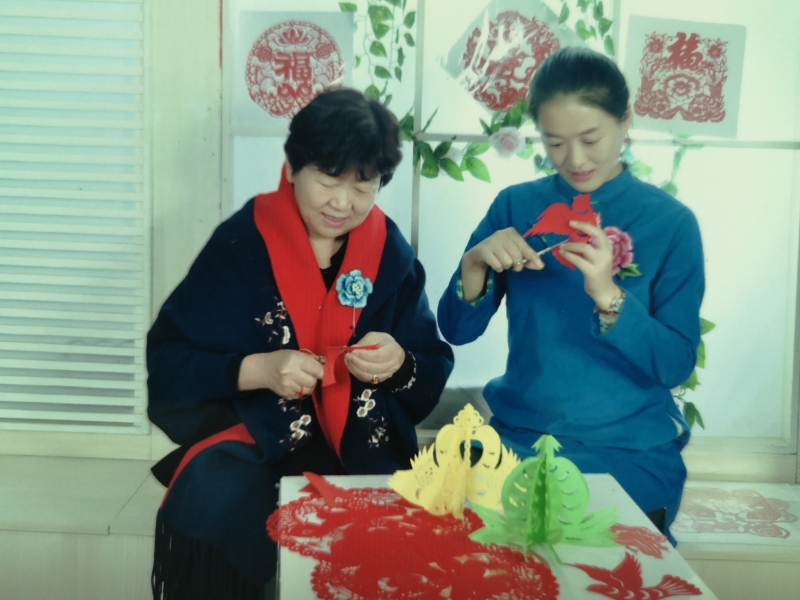“First, we fold the paper three times, and then we can cut it into all kinds of flowers.” At a paper-cut class recently held by the Korla Cultural Center, Yang Aifeng demonstrated while explaining. A piece of red paper was flipped in the hands of the trainees. Soon, lifelike plum blossoms, peonies, lotus flowers and snowflakes came into being.

Photo shows Yang Aifeng (first from right) teaches paper-cutting skills to trainees at the Korla Cultural Center in Korla City, northwest China’s Xinjiang. (Photo offered by Yang Aifeng)
Yang Aifeng is the representative trustee of paper cutting of the intangible cultural heritage project in Bayingolin Mongolian Autonomous Prefecture, northwest China’s Xinjiang. Unlike traditional paper cutting, Yang Aifeng combines "cutting" and "carving" and often sits for hours with her scissors and nicking tool. When people ask her why does she work so hard? She said: “I love paper cutting to the point of obsession, and as soon as a new idea comes up in my mind, I want to cut it out immediately. It's a pleasure to cut out a work that I like and I don't feel tired.”
Paper-cutting is easy to learn but difficult to master. A seemingly simple cut, each is a test for the paper cutter's skills. To be able to cut out vivid works, Yang Aifeng, in her spare time, not only humbly seeks advice from old artists who are good at paper-cutting, but also successively participates in the training and research courses for people who inherit intangible cultural heritage organized by the Women's Federation of the Xinjiang Uygur Autonomous Region, Xinjiang University, Shanghai University and other units. With continuous refinement and diligent practice day after day, her paper-cutting skills have matured and she has created many paper-cutting works that are rich in details and reflect the changes of the times.

Photo shows the paper-cutting work Along the River During the Qingming Festival (part) created by Yang Aifeng and her daughter. (Photo offered by Yang Aifeng)
Under the influence of Yang Aifeng, her daughter He Yinping learned paper-cutting from a young age. Yang Aifeng taught her by example and constantly refined her skills, and He Yinping's paper-cutting skills have been getting better. He Yinping also combines her hobby with her work as a docent at the Korla Folk Culture Museum. “After showing the audience around, I will teach them some simple paper cuttings in the activity room so that people can further understand the traditional skills," the 36-year-old He Yinping said.
The most memorable work for them are the series paper-cutting works named "Along the River During the Qingming Festival", which took more than two years to complete. There are 14 works, each 95cm long and 41cm wide, in which the characters such as cows, horses, donkeys, mules, camels and other livestock are lifelike, the houses and towers have their own characteristics, and the scenes and characters seem to break the boundaries of time and space, giving people a sense of immersion.
In 2015, Yang Aifeng was hired as a paper-cutting teacher by the Culture Museum of Korla City, and has so far conducted 21 training sessions of paper-cutting, with more than 2,000 trainees. In addition, Yang Aifeng and her daughter often go to communities, children's welfare institutions, farmers' night schools, etc. to teach the skills, and serve as extracurricular paper-cutting teachers in several primary and secondary schools in Korla City, cultivating many paper-cutting enthusiasts.

Photo shows Yang Aifeng and her daughter make paper-cutting works. (Photo offered by Yang Aifeng)
New era, new life, new feelings. Based on the inheritance of paper-cutting culture, Yang Aifeng and her daughter also integrate paper-cutting elements with traditional culture, core socialist values and rural revitalization, and express them in the form of paper-cutting, constantly endowing their works with the connotation of the times. At present, they are working together to create the paper-cutting work named the beautiful Xinjiang version of the twenty-four solar terms, "this group of works with mulberry paper as raw material, and the Tianshan Tianchi, Xinjiang International Grand Bazaar and other places as the main content, and are embellished with some flowers in the middle. When mulberry paper meets paper-cutting, I hope the two kinds of intangible cultural heritages can collide out new sparks," He Yinping said. And in the next step, they plan to do colorful paper-cutting and combine paper-cutting with cultural creations, so that the ancient intangible cultural heritage skills can be accepted and liked by more and more people.
(A written permission shall be obtained for reprinting, excerpting, copying and mirroring of the contents published on this website. Unauthorized aforementioned act shall be deemed an infringement, of which the actor shall be held accountable under the law.)









